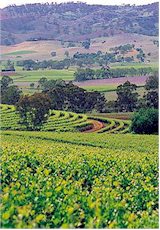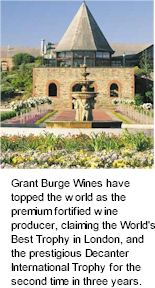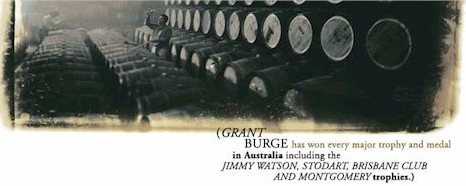


The company has a strong commitment to its loyal Australian consumers and also energetically pursues overseas markets in the United Kingdom, Europe, Canada, the United States and Asia. Grant Burge is a fifth generation winemaker absolutely committed to the Barossa Valley. He strongly believes that fine wines are born in the vineyard and that vineyards are the cradle of wine quality.

With this in mind, he has developed one of the most extensive networks of premium quality vineyards in Australia strategically positioned in the Barossa. The Grant Burge Wines offering is based around individual vineyard selections from the finest vineyards in the Barossa. With each of his Barossa vineyards having different climates, soils and characters, Grant matches them with suitable grape varieties, ensuring harvests of the best quality fruit. His most recent vineyard addition is Corryton Park in the cooler climate of the Eden Valley.
Grant Burge has been awarded every major trophy and medal in Australia, including the Jimmy Watson, Stodart, Brisbane Club and Montgomery Trophies. The winery Cellar Door overlooking the banks of the picturesque Jacobs Creek was awarded Vogue Entertaining Winery of the Year. Prices vary from $10 for the Barossa Vines range to $100 for Meshach Shiraz, the company's flagship wine. Named for Grant's great-grandfather who ignited the family's passion for winemaking, Meshach is considered a worthy contender for the title of "Australia's best wine".
All of Grant Burge Wines' reds are produced at the Illaparra Winery, which Grant purchased in 1993; white wines are vinified at his Barossa Vines Winery purchased in 1999. Grant Burge is a loyal and dedicated Barossan and he proudly displays the Barossa name on every bottle as an assurance of regional integrity.

Nearly a decade ago, Grant Burge embarked on his greatest venture since the introduction of Grant Burge Wines – the establishment of a stunning new vineyard on some of the highest land suitable for viticulture in South Australia. Just after the start of the new millennium, the first vines of Cabernet Sauvignon, Merlot and a smattering of Petit Verdot, were planted over part of an historic estate, Corryton Park near Mount Crawford, high above the southern end of the Barossa Valley.
The history of Corryton Park goes back more than 160 years when the land was first purchased in 1845 by noted South Australian pastoralist, Mr David Randall. Many owners later Grant Burge bought the property and, as he said at the time: “Corryton Park is being established as a 20 year project to produce premium wine grapes of great intensity and maturity. I have no illusions for this vineyard for at least another 10 years.” Today, the premium Cabernet Sauvignon fruit from Corryton Park is of such exceptional quality it has been chosen to form the backbone and heart of an iconic Grant Burge wine – his premium Cabernet Sauvignon, Shadrach. Already, the wine has been awarded trophies and heralded as one of the Top 100 wines in Australia.
To understand the Grant Burge philosophy it is worth going back to the early days of Grant Burge the winemaker. As he recalls today: “I have had years of experience to produce my latest Shadrach. That experience is based theories to produce the finest in Cabernet Sauvignon which go back to the late 1970s and early 1980s"
As a fifth generation member of a great winemaking and grape growing dynasty that has been part of the Barossa since 1855, Grant Burge's commitment to the Barossa is absolute. He strongly believes fine wines are born in the vineyard, and theat the vineyard is the cradle of wine quality. With this in mind, Grant has carefully selected his source vineyards for their suitability to the individual varieties grown at each. Grant Burge Wines is Barossa through and through, the Grant Burge label is your guarantee of quality and integrity.
